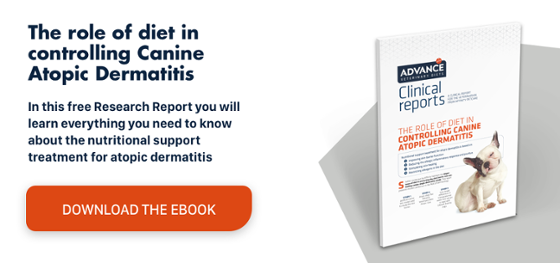Skin cancer in dogs. Nutritional status and dietary advice
What is skin cancer and how can we identify it?
Skin cancer is one of the most commonly encountered skin diseases in dogs. Lesions appear as nodules, pedunculated masses or abnormal prominences which may be accompanied by a loss of tissue integrity.
Depending on the area or which skin cells are affected, skin cancers are known by various names (lipoma, papilloma, haemangioma, etc.) and are characterised by their rapid progression (typical of benign tumours) and tendency for metastasis (feature of malignant tumours). The incidence of skin cancer is on the rise because dogs enjoy a longer life expectancy, giving them more time to develop these skin dysplasias.
Treatment is designed to suppress cancer cells, whether through surgery, chemotherapy or radiation therapy, and control secondary clinical signs such as pain, nausea and vomiting, infection or fever. Weight loss due to anorexia is very common in these cases, as both the disease process and chemotherapy can lead to a loss of appetite. It is important to assess the animal’s body and nutritional status. Dogs with cancer have increased nutritional needs (in terms of energy and nutrients) so it is essential to monitor their weight and muscle mass, as some cases can lead to the onset of cachexia and a decline in the animal’s general condition. The excessive loss of weight and muscle mass is not always due to a neoplasm, as these signs also appear in other diseases, such as diabetes mellitus, heart disease, kidney disease and hyperthyroidism.
Nutrition during skin cancer treatment
The nutrition dogs receive during the disease process is beneficial in terms of both its treatment and its prevention. Diets rich in natural antioxidants, such as beta-carotenes, selenium, retinoids, and vitamins C and E, have been shown to prevent carcinogenesis.
In cancer, the two key nutritional objectives are to inhibit tumour growth and prevent or treat cachexia. As glucose is the key energy substrate for growing tumour cells, the strategy involves forcing the tumour to use other substrates and therefore reduce cell proliferation, so we should choose foods high in fat (minimum 25%) and proteins (minimum 35%) and low in carbohydrates. An increased protein and fat intake will also help compensate for greater losses of these nutrients due to cancer cachexia. It is also very important to supply amino acids through the diet since they are shown to reduce tumour growth, whereas the use of antioxidant supplements is controversial as they can favour tumour cell survival. The consumption of fish oil supplements has been associated with better recovery from radiation therapy, with potentiation of tumour cell death and reduced inflammation of the surrounding tissue.
Skin inflammation in atopic dogs may be related to the onset and hyperplasia of skin lesions. If such lesions are noted, and especially if there is associated protrusion, the pruritus present in these dogs and the consequent scratching can cause wounds susceptible to infection, so the special characteristics of their diet must also be taken into account.


